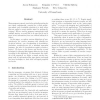Free Online Productivity Tools
i2Speak
i2Symbol
i2OCR
iTex2Img
iWeb2Print
iWeb2Shot
i2Type
iPdf2Split
iPdf2Merge
i2Bopomofo
i2Arabic
i2Style
i2Image
i2PDF
iLatex2Rtf
Sci2ools
CCS
2009
ACM
2009
ACM
Reactive noninterference
Many programs operate reactively, patiently waiting for user input, subsequently running for a while producing output, and eventually returning to a state where they are ready to accept another input (or perhaps diverging). When a reactive program communicates with multiple parties, we would like to be sure that it can be given secret information from one without leaking it to others. In this paper, we explore various definitions of noninterference for reactive programs and identify two of special interest—one corresponding to terminationinsensitive noninterference for a standard sequential language, the other to termination-sensitive noninterference. We focus on the former and develop a proof technique for showing that program behaviors are secure according to this definition. To demonstrate the viability of the approach, we define a simple reactive language with an information-flow type system and apply our proof technique to show that well-typed programs are secure.
| Added | 19 May 2010 |
| Updated | 19 May 2010 |
| Type | Conference |
| Year | 2009 |
| Where | CCS |
| Authors | Aaron Bohannon, Benjamin C. Pierce, Vilhelm Sjöberg, Stephanie Weirich, Steve Zdancewic |
Comments (0)

